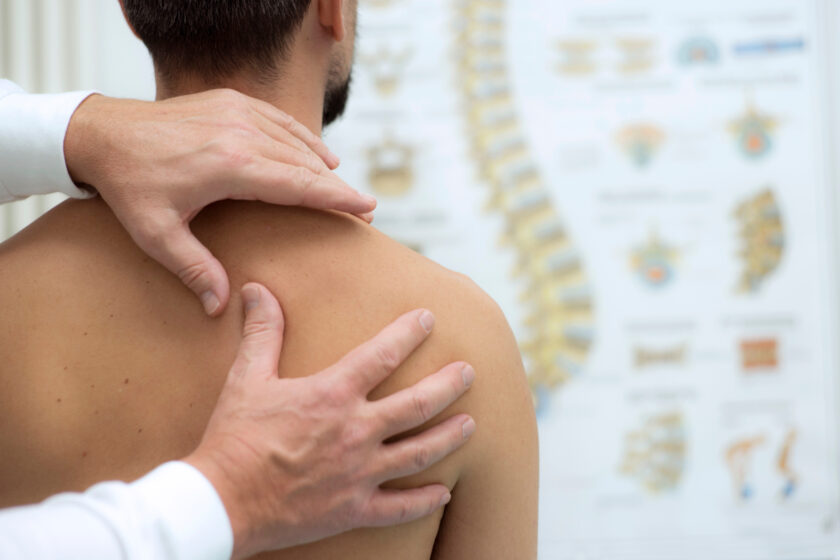Uszkodzenie stawu barkowo-obojczykowego (AC)
BCM
19 września 2023

Z wichnięcie barku jest dość powszechnym urazem, zwłaszcza w niektórych dyscyplinach sportowych. Większość takich urazów to uszkodzenie stawu barkowo-obojczykowego (AC). Staw AC jest połączeniem między łopatką, a obojczykiem. Zwichnięcie barku oraz uszkodzenie stawu barkowo- obojczykowego są często mylone ze sobą. A są to zupełnie różne urazy. Ten przewodnik pomoże zrozumieć: co to jest staw barkowo – obojczykowy (AC)? Jak rozpoznać uszkodzenie stawu barkowo – obojczykowego? Jak leczy się uszkodzenie stawu barkowo – obojczykowego?
Anatomia
Jak zbudowany jest staw AC i jaka jest jego funkcja? Staw barkowy składa się z trzech kości: łopatki, kości ramieniowej i obojczyka. Część łopatki, która tworzy sklepienie stawu nazywa się wyrostkiem barkowym. Staw AC jest miejscem połączenia wyrostka barkowego i obojczyka. Więzadła stabilizują to połączenie. Więzadła to pasma tkanek miękkich łączących kości.
Więzadła barkowo – obojczykowe otaczają i stabilizują staw AC, tworząc torebkę stawową. Torebka stawowa to wodoszczelny woreczek, który otacza połączenie i jest wypełniony płynem stawowym. Dwa inne więzadła, więzadła kruczo – obojczykowe, stabilizują obojczyk przyczepiając się do wyrostka kruczego łopatki. Uszkodzenie stawu AC klasyfikuje się od łagodnego do ciężkiego, w zależności od tego, które z więzadeł uległy naciągnięciu lub rozerwaniu. Najłagodniejszym rodzajem urazu jest uszkodzenie stawu barkowo-obojczykowego polegające na niewielkim naciągnięciu więzadeł barkowo – obojczykowych.
Lekarze nazywają to uszkodzeniem 1-go stopnia, natomiast 2-gi stopień uszkodzenia stawu AC to uszkodzenie więzadeł AC i więzadeł kruczo – obojczykowych. Całkowite rozerwanie więzadeł AC i więzadeł kruczo – obojczykowych jest uszkodzeniem 3-go stopnia. Ten rodzaj powoduje powstanie tzw. „objawu klawisza”.
Uszkodzenie stawu barkowo-obojczykowego (AC) – przyczyny
Jak dochodzi do uszkodzenia stawu AC?
Najczęstsza przyczyna uszkodzenia stawu stawu barkowo-obojczykowego (AC) to upadek na ramię. Wtedy ramię uderza o podłoże, a siła uderzenia przemieszcza łopatkę ku dołowi. Ponieważ obijczyk jest przymocowany do klatki piersiowej, nie może przemieścić się wystarczająco, aby podążać za ruchem łopatki. Rezultat – więzadła stabilizujące staw AC uszkadzają się, powodując przemieszczenie obojczyka.
Uszkodzenie stawu barkowo-obojczykowego (AC) – objawy
Wahają się od niewielkiego bólu w stawie AC do intensywnego bólu w przypadku całkowitego zwichnięcia. Uszkodzenie drugiego i trzeciego stopnia może powodować obrzęki oraz zasinienia.
W uszkodzeniu trzeciego stopnia można odczuć wrażenie przemieszczania się luźnego obojczyka (tzw. objaw klawisza) oraz deformację stawu AC.
Diagnoza
Jakie badania przeprowadzi lekarz?
Lekarz będzie potrzebował informacji na temat urazu i szczegółowej historii choroby. Należy odpowiedzieć na pytania dotyczące ostatnich urazów barku. Wymagana jest ocena bólu w skali od jednego do dziesięciu.
Rozpoznanie jest zazwyczaj poprzedzone przez badanie fizykalne. Lekarz może poruszać barkiem, i choć może to być bolesne, ale bardzo ważne, aby lekarz dokładnie wiedział, gdzie występuje ból i jakie ruchy go wywołują. Lekarz może zlecić zdjęcie rtg, które może wykazać uszkodzenia w stawie AC oraz jednocześnie wykluczyć złamanie obojczyka. Czasem wykonuje się rtg z obciążeniem obu rąk, celem potwierdzenia niestabilności.
Jakie opcje leczenia są dostępne?
Uszkodzenie stawu barkowo-obojczykowego (AC) – leczenie nieoperacyjne
Leczenie 1-go lub 2-go stopnia uszkodzenia zwykle polega na leczeniu przeciwbólowym i krótkim okresie odpoczynku przy użyciu podwieszki. Program rehabilitacji powinien być określony przez fizjoterapeutę. Leczenie 3-go stopnia uszkodzenia AC jest nieco kontrowersyjne. W wielu badaniach nie wykazano różnicy pomiędzy leczeniem chirurgicznym i zachowawczym. Nawet w przypadku zabiegu deformacja okolicy urazu może pozostać. A znaczna część osób, które poddają się zabiegowi, potrzebuje innej, dodatkowej operacji w terminie późniejszym.
Badania pokazały, co dzieje się ze stawem AC w urazie. Wiele osób, niezależnie od tego, czy przeszło leczenie operacyjne czy nieoperacyjne , będzie wymagało operacji w przyszłości. Uszkodzony staw ulega zmianom zwyrodnieniowym szybciej niż staw nieuszkodzony. Z biegiem czasu staje się zdeformowany i bolesny. Proces ten może potrwać kilka lat, ale czasami dzieje się to w ciągu jednego roku – dwóch lat. Jak widać uszkodzenie stawu barkowo – obojczykowego może mieć naprawdę poważne i długofalowe konsekwencje.
Uszkodzenie stawu barkowo-obojczykowego (AC) – leczenie operacyjne
Niektórzy chirurdzy wolą operować uszkodzenia stawu AC 3-go stopnia, zwłaszcza u sportowców dyscyplin rzutowych, na wysokim poziomie. Zabieg operacyjny odbywa się zazwyczaj poprzez nacięcie ponad stawem AC. Chirurg ustawia struktury stawu we właściwej pozycji (repozycja). Śrubę lub inny rodzaj mocowania jest stosowany do stabilizacji obojczyka na czas biologicznego gojenia więzadeł. Stabilizacja stawu AC za pomocą śruby polega na połączeniu końca barkowego obojczyka z wyrostkiem kruczym łopatki. Niektórzy operatorzy stosują taśmę do stabilizacji obojczyka z wyrostkiem kruczym.
W obrębie obojczyka oraz wyrostka kruczego wykonuje się niewielkie otwory, przewleka się przez nie taśmę i mocuje. W niektórych przypadkach wykonuje się również naprawę więzadeł stawu. Jeżeli stosuje się śrubę, zwykle usuwa się ją w okresie od sześciu do ośmiu tygodni po zabiegu.
Uszkodzenie stawu barkowo-obojczykowego (AC) w Szpitalu Zakonu Bonifratrów leczy zespół specjalistów w dziedzinie ortopedii i traumatologii:
- lek. Stanisław Szymanik – Kierownik Oddziału Diagnostyczno-Leczniczego
- lek. Michał Latos
- lek. Michał Starmach

